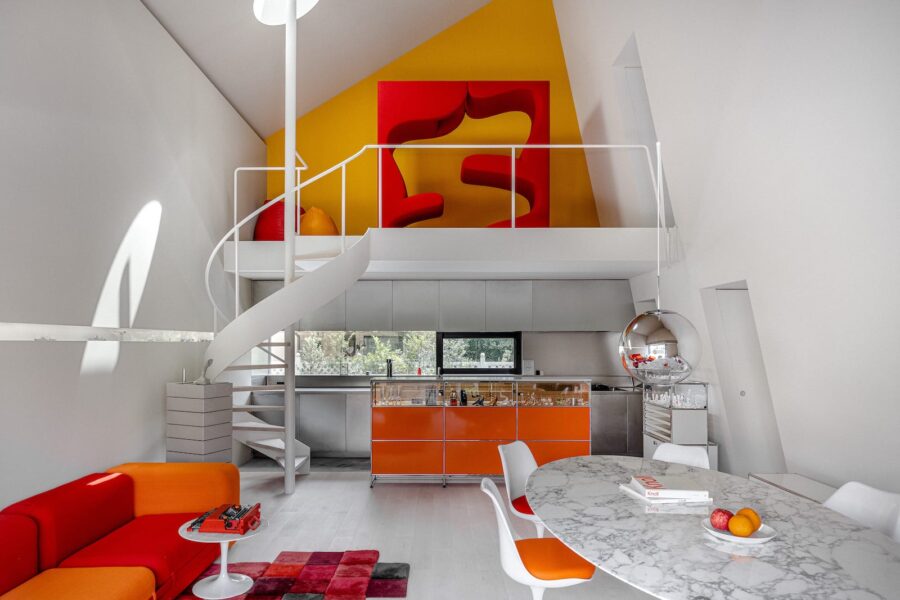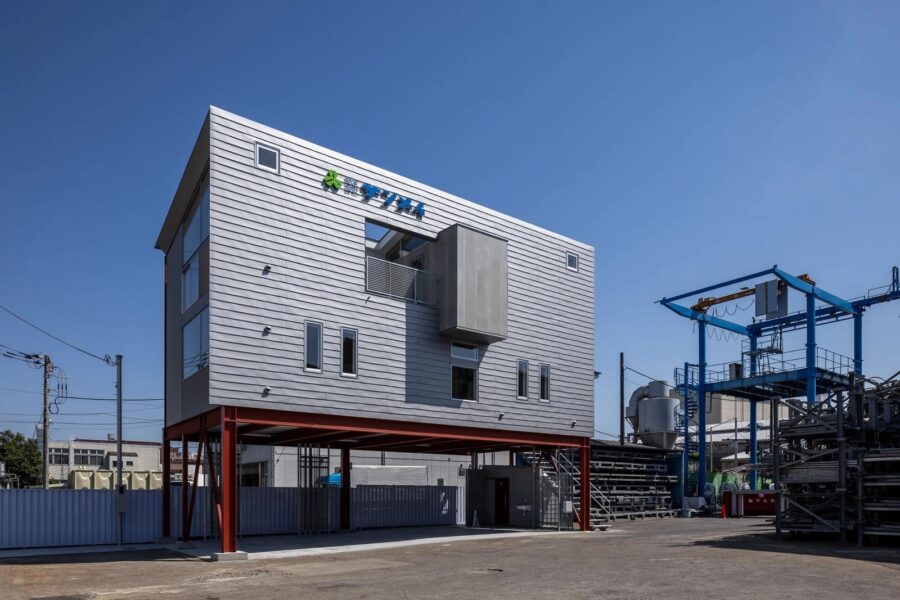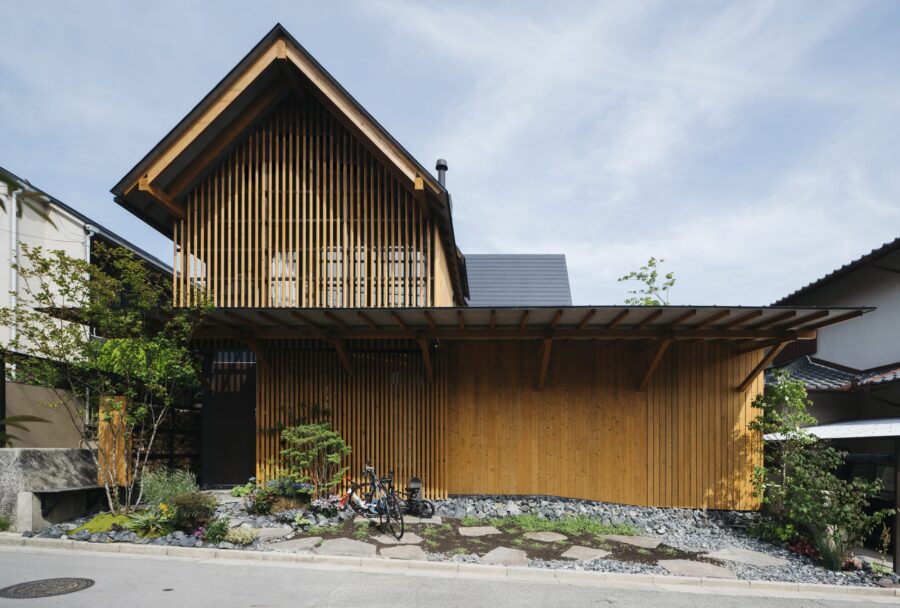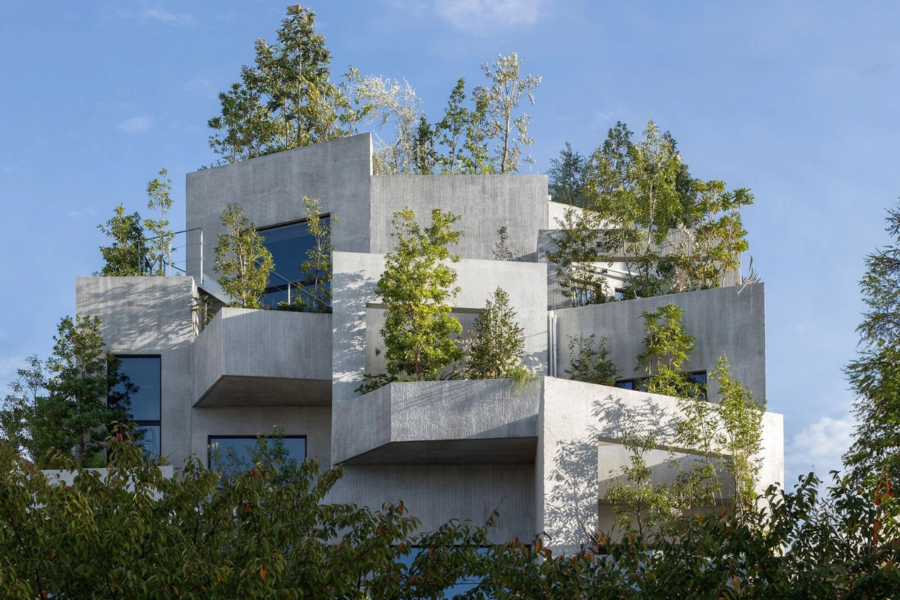壁に開口を開けることは、生きるための環境をつくる行為だと思う。
内部に風や光、風景が入り込み、暮らしていて気持ちがよいという根源的な住宅。
この住宅では、隣地の建物と視線が交差しないように調整した開口と、周辺も関係なしに、この位置にあると光や風が気持ちよいだろうと感覚的に設けた開口もある。
その矛盾した両者を同居させることで隣家との間合い、都市との距離感、親と子の距離を離しつつ、つなぐ関係を目指した。
雑居ビル、マンション、ホテルが建ち並ぶ都心の大通り沿いに計画した二世帯住宅である。外周にテラスや縦動線などを配置した、入れ子のような平面構成になっている。
バッファーとしてのテラス、それと連続する屋外階段、大きくゆとりのある内部階段と踊り場をもち、その隙間に各世帯の占有空間、二世帯の共有空間を挿入した。
各階のテラスを介して、世帯同士のゆるいつながりを生み出している。テラスは半外部でありながら内部的な仕上げで統一し、内部階段と踊り場は隣地の建物に囲まれた裏手にはあるものの、開口を多数設けることで外部的な明るい空間とした。
また、親世帯の住居である2階と、子世帯の住居である4・5階の間には、あえて用途を規定しない余白の階層を挿入している。用途のない場所は、この住宅の床面積の半分近くを占め、そこを「小さな敷地」と呼ぶことにした。
家の中に小さな敷地をいくつも設けることで、我々が建築を考えるのと同じように、使い手はその場所を自ら設計して生活をしていく。
幅広でゆとりのある階段でお茶を飲みながら本を読んだり、部屋のような大きな踊り場で仕事をしたり、内部のようなテラスでランチをしたり、余白の3階を写真スタジオとして利用したり。建物の中に開口を開け、小さな敷地をもつことで本能的な生活の風景を生み出し、機能を超えた生きるための環境をつくることを目指した。(武井良祐、太田 翔)
A two-family house connected by an opening inside and a margin
We think that opening up the walls is an act of creating an environment for living.
This is a primitive house where wind, light, and scenery enter the interior and make it pleasant to live in.
In this house, some of the openings were adjusted to prevent the line of sight from intersecting with the neighboring buildings. In contrast, others were created on a sensory level, regardless of the surrounding area, thinking that the light and wind would be pleasant at this location.
By co-locating these contradictory openings, I aimed to create a relationship that connects the distance between the neighboring house and the city and the distance between parents and children.
This is a two-family house planned along the main street in the city’s heart, lined with various buildings, condominiums, and hotels. It has a nested plan structure with terraces and vertical lines of flow around the perimeter.
It has a terrace as a buffer, a continuous outdoor staircase, a large and spacious internal staircase, and a landing, and in the gaps between them, spaces occupied by each household and spaces shared by the two families.
A loose connection between the households is created through the terraces on each floor. The decks are semi-exterior but finished in any interior style. The internal staircases and landings are located at the back of the house, surrounded by neighboring buildings, but with many openings to create a bright exterior space.
Also, between the second floor, which is the residence of the parent family, and the fourth and fifth floors, which are the children’s residences, we intentionally inserted a blank hierarchy with no defined use. The unused area occupies almost half of the house’s floor area, and we decided to call it a “small site.”
By creating several small sites within the house, the users will be able to design their own living space in the same way that we think about architecture.
Reading a book with a cup of tea on the wide, spacious staircase, working on the large, room-like landing, having lunch on the interior-like terrace, and using the blank third floor as a photography studio. By opening up the building and having space, we aimed to create an instinctive landscape of life and create an environment for living beyond function. (Ryosuke Takei, Sho Ohta)
【湯島の住宅】
所在地:非公表
用途:戸建住宅(二世帯)
クライアント:個人
竣工:2020年
設計:OSTR
担当:武井良祐、太田 翔
構造設計:円酒構造設計
照明計画:ぼんぼり光環境計画
施工:中央構造
撮影:井手野下貴弘
工事種別:新築
構造:RC造+耐震壁付きラーメン構造
規模:地上5階
敷地面積:86.68m²
建築面積:69.33m²
延床面積:311.61m²
設計期間:2017.04-2018.08
施工期間:2018.09-2020.02
【Yushima House】
Location: Private
Principal use: Private house (two-family house)
Client: Individual
Completion: 2020
Architect: OSTR
Design team: Ryosuke Takei, Sho Ohta
Structure engineer: Enshu Structural Consultants
Lighting design: BONBORI Lighting Architect & Associates
Contractor: Cyuou-kouzou
Photographs: Takahiro Idenoshita
Construction type: New building
Main structure: Reinforced Concrete construction + Rigid frame structure with earthquake-resistant wall
Building scale: 5 stories
Site area: 86.68m²
Building area: 69.33m²
Total floor area: 311.61m²
Design term: 2017.04-2018.08
Construction term: 2018.05-2020.02








